A Comprehensive Analysis of Capital Budgeting Techniques and Methods
VerifiedAdded on 2022/11/07
|6
|2730
|391
Report
AI Summary
This report provides a comprehensive analysis of capital budgeting techniques, emphasizing the importance of sensitivity, scenario, break-even, and simulation analyses in financial decision-making. It explores how these techniques, in conjunction with the discounted cash flow (DCF) method, specifically Net Present Value (NPV) and Internal Rate of Return (IRR), are crucial for assessing project viability. The report details each analysis type, explaining their application in evaluating potential investments, managing risks, and determining project profitability. Sensitivity analysis helps in assessing the impact of variable changes, scenario analysis considers different future possibilities, break-even analysis determines the point of profitability, and simulation analysis uses computer-generated models to predict outcomes. The report highlights the interdependence of these methods and their direct relation to capital budgeting, emphasizing the need for accurate financial forecasting and the time value of money in investment decisions. References are included for further reading.
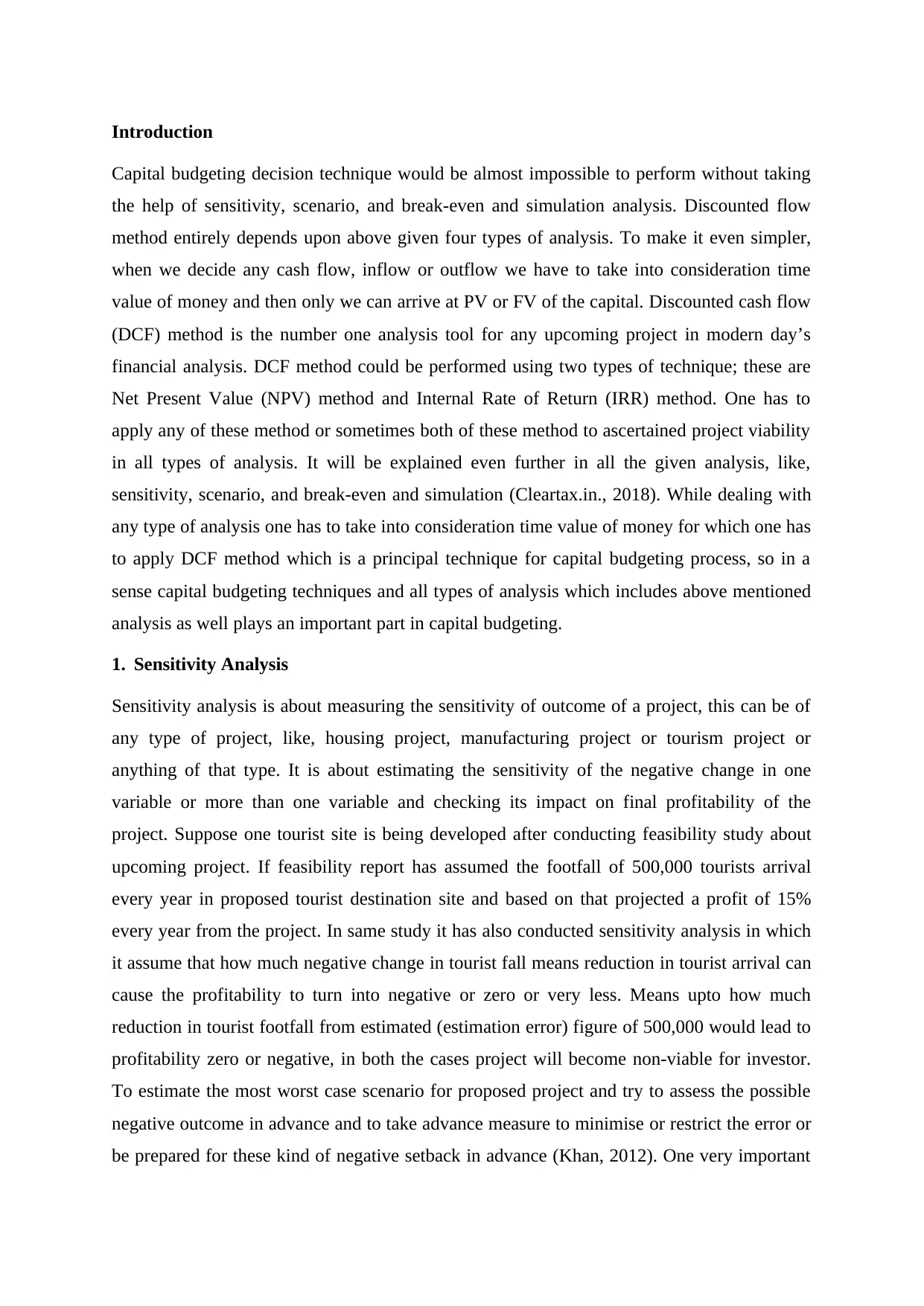
Introduction
Capital budgeting decision technique would be almost impossible to perform without taking
the help of sensitivity, scenario, and break-even and simulation analysis. Discounted flow
method entirely depends upon above given four types of analysis. To make it even simpler,
when we decide any cash flow, inflow or outflow we have to take into consideration time
value of money and then only we can arrive at PV or FV of the capital. Discounted cash flow
(DCF) method is the number one analysis tool for any upcoming project in modern day’s
financial analysis. DCF method could be performed using two types of technique; these are
Net Present Value (NPV) method and Internal Rate of Return (IRR) method. One has to
apply any of these method or sometimes both of these method to ascertained project viability
in all types of analysis. It will be explained even further in all the given analysis, like,
sensitivity, scenario, and break-even and simulation (Cleartax.in., 2018). While dealing with
any type of analysis one has to take into consideration time value of money for which one has
to apply DCF method which is a principal technique for capital budgeting process, so in a
sense capital budgeting techniques and all types of analysis which includes above mentioned
analysis as well plays an important part in capital budgeting.
1. Sensitivity Analysis
Sensitivity analysis is about measuring the sensitivity of outcome of a project, this can be of
any type of project, like, housing project, manufacturing project or tourism project or
anything of that type. It is about estimating the sensitivity of the negative change in one
variable or more than one variable and checking its impact on final profitability of the
project. Suppose one tourist site is being developed after conducting feasibility study about
upcoming project. If feasibility report has assumed the footfall of 500,000 tourists arrival
every year in proposed tourist destination site and based on that projected a profit of 15%
every year from the project. In same study it has also conducted sensitivity analysis in which
it assume that how much negative change in tourist fall means reduction in tourist arrival can
cause the profitability to turn into negative or zero or very less. Means upto how much
reduction in tourist footfall from estimated (estimation error) figure of 500,000 would lead to
profitability zero or negative, in both the cases project will become non-viable for investor.
To estimate the most worst case scenario for proposed project and try to assess the possible
negative outcome in advance and to take advance measure to minimise or restrict the error or
be prepared for these kind of negative setback in advance (Khan, 2012). One very important
Capital budgeting decision technique would be almost impossible to perform without taking
the help of sensitivity, scenario, and break-even and simulation analysis. Discounted flow
method entirely depends upon above given four types of analysis. To make it even simpler,
when we decide any cash flow, inflow or outflow we have to take into consideration time
value of money and then only we can arrive at PV or FV of the capital. Discounted cash flow
(DCF) method is the number one analysis tool for any upcoming project in modern day’s
financial analysis. DCF method could be performed using two types of technique; these are
Net Present Value (NPV) method and Internal Rate of Return (IRR) method. One has to
apply any of these method or sometimes both of these method to ascertained project viability
in all types of analysis. It will be explained even further in all the given analysis, like,
sensitivity, scenario, and break-even and simulation (Cleartax.in., 2018). While dealing with
any type of analysis one has to take into consideration time value of money for which one has
to apply DCF method which is a principal technique for capital budgeting process, so in a
sense capital budgeting techniques and all types of analysis which includes above mentioned
analysis as well plays an important part in capital budgeting.
1. Sensitivity Analysis
Sensitivity analysis is about measuring the sensitivity of outcome of a project, this can be of
any type of project, like, housing project, manufacturing project or tourism project or
anything of that type. It is about estimating the sensitivity of the negative change in one
variable or more than one variable and checking its impact on final profitability of the
project. Suppose one tourist site is being developed after conducting feasibility study about
upcoming project. If feasibility report has assumed the footfall of 500,000 tourists arrival
every year in proposed tourist destination site and based on that projected a profit of 15%
every year from the project. In same study it has also conducted sensitivity analysis in which
it assume that how much negative change in tourist fall means reduction in tourist arrival can
cause the profitability to turn into negative or zero or very less. Means upto how much
reduction in tourist footfall from estimated (estimation error) figure of 500,000 would lead to
profitability zero or negative, in both the cases project will become non-viable for investor.
To estimate the most worst case scenario for proposed project and try to assess the possible
negative outcome in advance and to take advance measure to minimise or restrict the error or
be prepared for these kind of negative setback in advance (Khan, 2012). One very important
Paraphrase This Document
Need a fresh take? Get an instant paraphrase of this document with our AI Paraphraser
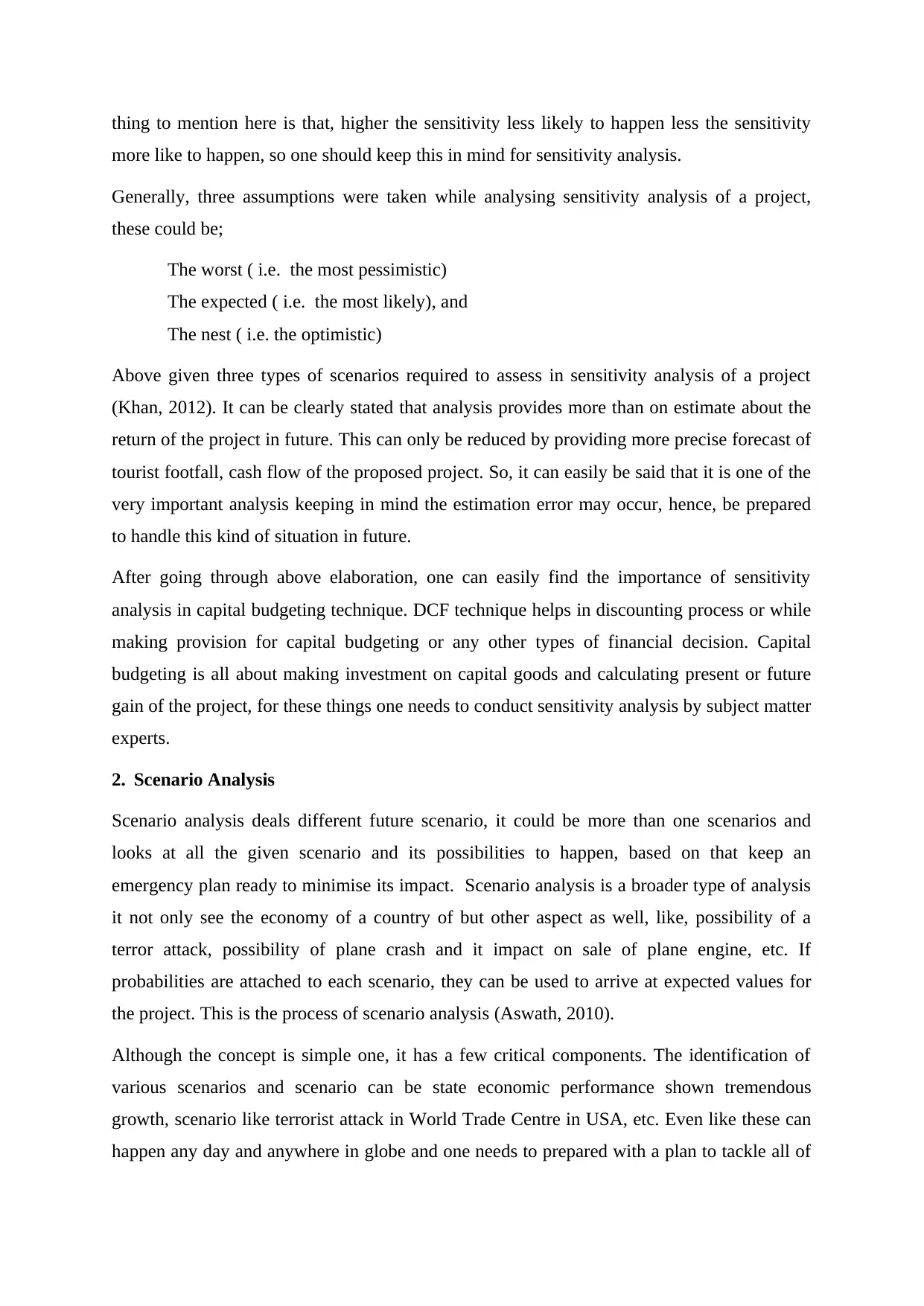
thing to mention here is that, higher the sensitivity less likely to happen less the sensitivity
more like to happen, so one should keep this in mind for sensitivity analysis.
Generally, three assumptions were taken while analysing sensitivity analysis of a project,
these could be;
The worst ( i.e. the most pessimistic)
The expected ( i.e. the most likely), and
The nest ( i.e. the optimistic)
Above given three types of scenarios required to assess in sensitivity analysis of a project
(Khan, 2012). It can be clearly stated that analysis provides more than on estimate about the
return of the project in future. This can only be reduced by providing more precise forecast of
tourist footfall, cash flow of the proposed project. So, it can easily be said that it is one of the
very important analysis keeping in mind the estimation error may occur, hence, be prepared
to handle this kind of situation in future.
After going through above elaboration, one can easily find the importance of sensitivity
analysis in capital budgeting technique. DCF technique helps in discounting process or while
making provision for capital budgeting or any other types of financial decision. Capital
budgeting is all about making investment on capital goods and calculating present or future
gain of the project, for these things one needs to conduct sensitivity analysis by subject matter
experts.
2. Scenario Analysis
Scenario analysis deals different future scenario, it could be more than one scenarios and
looks at all the given scenario and its possibilities to happen, based on that keep an
emergency plan ready to minimise its impact. Scenario analysis is a broader type of analysis
it not only see the economy of a country of but other aspect as well, like, possibility of a
terror attack, possibility of plane crash and it impact on sale of plane engine, etc. If
probabilities are attached to each scenario, they can be used to arrive at expected values for
the project. This is the process of scenario analysis (Aswath, 2010).
Although the concept is simple one, it has a few critical components. The identification of
various scenarios and scenario can be state economic performance shown tremendous
growth, scenario like terrorist attack in World Trade Centre in USA, etc. Even like these can
happen any day and anywhere in globe and one needs to prepared with a plan to tackle all of
more like to happen, so one should keep this in mind for sensitivity analysis.
Generally, three assumptions were taken while analysing sensitivity analysis of a project,
these could be;
The worst ( i.e. the most pessimistic)
The expected ( i.e. the most likely), and
The nest ( i.e. the optimistic)
Above given three types of scenarios required to assess in sensitivity analysis of a project
(Khan, 2012). It can be clearly stated that analysis provides more than on estimate about the
return of the project in future. This can only be reduced by providing more precise forecast of
tourist footfall, cash flow of the proposed project. So, it can easily be said that it is one of the
very important analysis keeping in mind the estimation error may occur, hence, be prepared
to handle this kind of situation in future.
After going through above elaboration, one can easily find the importance of sensitivity
analysis in capital budgeting technique. DCF technique helps in discounting process or while
making provision for capital budgeting or any other types of financial decision. Capital
budgeting is all about making investment on capital goods and calculating present or future
gain of the project, for these things one needs to conduct sensitivity analysis by subject matter
experts.
2. Scenario Analysis
Scenario analysis deals different future scenario, it could be more than one scenarios and
looks at all the given scenario and its possibilities to happen, based on that keep an
emergency plan ready to minimise its impact. Scenario analysis is a broader type of analysis
it not only see the economy of a country of but other aspect as well, like, possibility of a
terror attack, possibility of plane crash and it impact on sale of plane engine, etc. If
probabilities are attached to each scenario, they can be used to arrive at expected values for
the project. This is the process of scenario analysis (Aswath, 2010).
Although the concept is simple one, it has a few critical components. The identification of
various scenarios and scenario can be state economic performance shown tremendous
growth, scenario like terrorist attack in World Trade Centre in USA, etc. Even like these can
happen any day and anywhere in globe and one needs to prepared with a plan to tackle all of
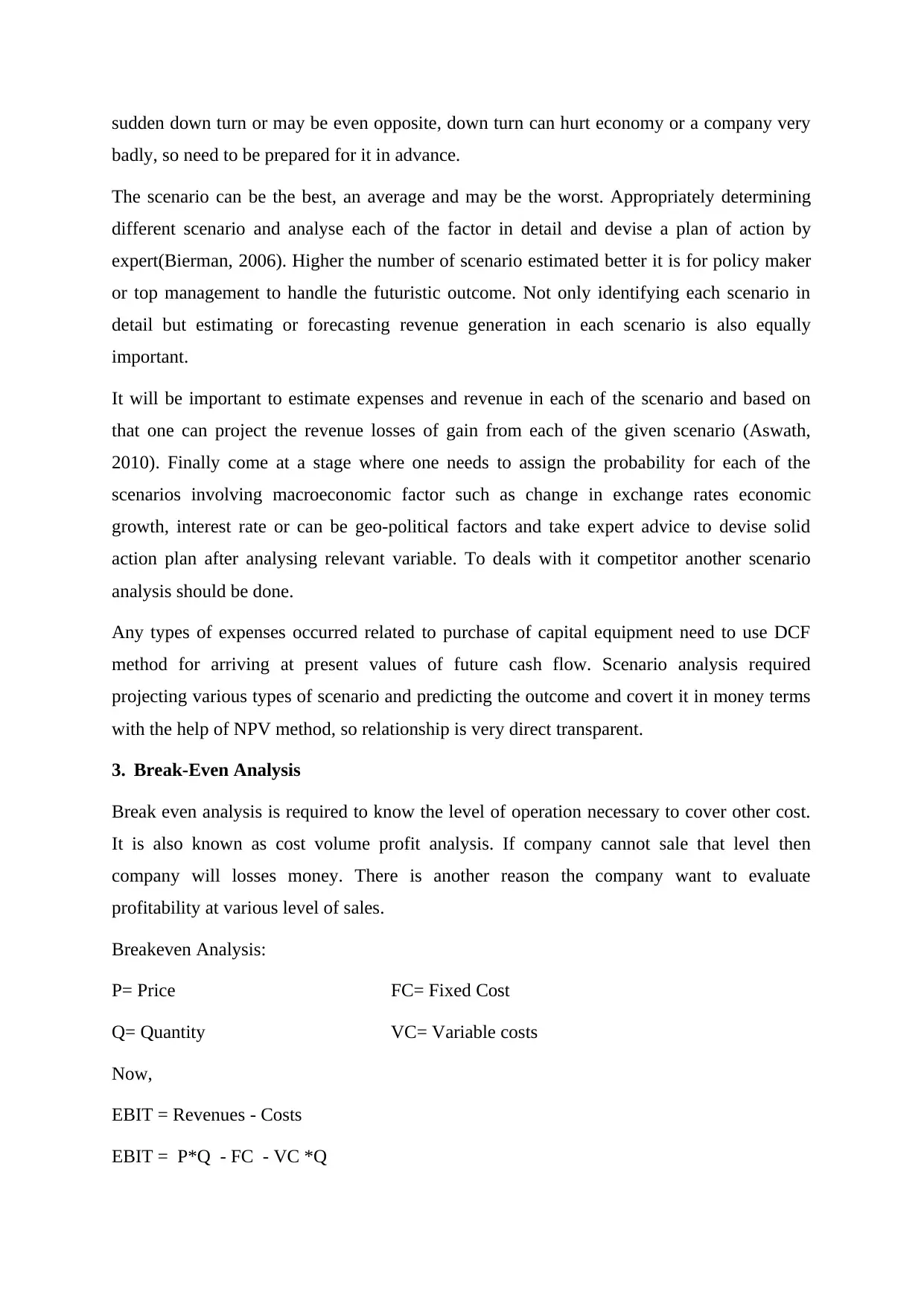
sudden down turn or may be even opposite, down turn can hurt economy or a company very
badly, so need to be prepared for it in advance.
The scenario can be the best, an average and may be the worst. Appropriately determining
different scenario and analyse each of the factor in detail and devise a plan of action by
expert(Bierman, 2006). Higher the number of scenario estimated better it is for policy maker
or top management to handle the futuristic outcome. Not only identifying each scenario in
detail but estimating or forecasting revenue generation in each scenario is also equally
important.
It will be important to estimate expenses and revenue in each of the scenario and based on
that one can project the revenue losses of gain from each of the given scenario (Aswath,
2010). Finally come at a stage where one needs to assign the probability for each of the
scenarios involving macroeconomic factor such as change in exchange rates economic
growth, interest rate or can be geo-political factors and take expert advice to devise solid
action plan after analysing relevant variable. To deals with it competitor another scenario
analysis should be done.
Any types of expenses occurred related to purchase of capital equipment need to use DCF
method for arriving at present values of future cash flow. Scenario analysis required
projecting various types of scenario and predicting the outcome and covert it in money terms
with the help of NPV method, so relationship is very direct transparent.
3. Break-Even Analysis
Break even analysis is required to know the level of operation necessary to cover other cost.
It is also known as cost volume profit analysis. If company cannot sale that level then
company will losses money. There is another reason the company want to evaluate
profitability at various level of sales.
Breakeven Analysis:
P= Price FC= Fixed Cost
Q= Quantity VC= Variable costs
Now,
EBIT = Revenues - Costs
EBIT = P*Q - FC - VC *Q
badly, so need to be prepared for it in advance.
The scenario can be the best, an average and may be the worst. Appropriately determining
different scenario and analyse each of the factor in detail and devise a plan of action by
expert(Bierman, 2006). Higher the number of scenario estimated better it is for policy maker
or top management to handle the futuristic outcome. Not only identifying each scenario in
detail but estimating or forecasting revenue generation in each scenario is also equally
important.
It will be important to estimate expenses and revenue in each of the scenario and based on
that one can project the revenue losses of gain from each of the given scenario (Aswath,
2010). Finally come at a stage where one needs to assign the probability for each of the
scenarios involving macroeconomic factor such as change in exchange rates economic
growth, interest rate or can be geo-political factors and take expert advice to devise solid
action plan after analysing relevant variable. To deals with it competitor another scenario
analysis should be done.
Any types of expenses occurred related to purchase of capital equipment need to use DCF
method for arriving at present values of future cash flow. Scenario analysis required
projecting various types of scenario and predicting the outcome and covert it in money terms
with the help of NPV method, so relationship is very direct transparent.
3. Break-Even Analysis
Break even analysis is required to know the level of operation necessary to cover other cost.
It is also known as cost volume profit analysis. If company cannot sale that level then
company will losses money. There is another reason the company want to evaluate
profitability at various level of sales.
Breakeven Analysis:
P= Price FC= Fixed Cost
Q= Quantity VC= Variable costs
Now,
EBIT = Revenues - Costs
EBIT = P*Q - FC - VC *Q
⊘ This is a preview!⊘
Do you want full access?
Subscribe today to unlock all pages.

Trusted by 1+ million students worldwide
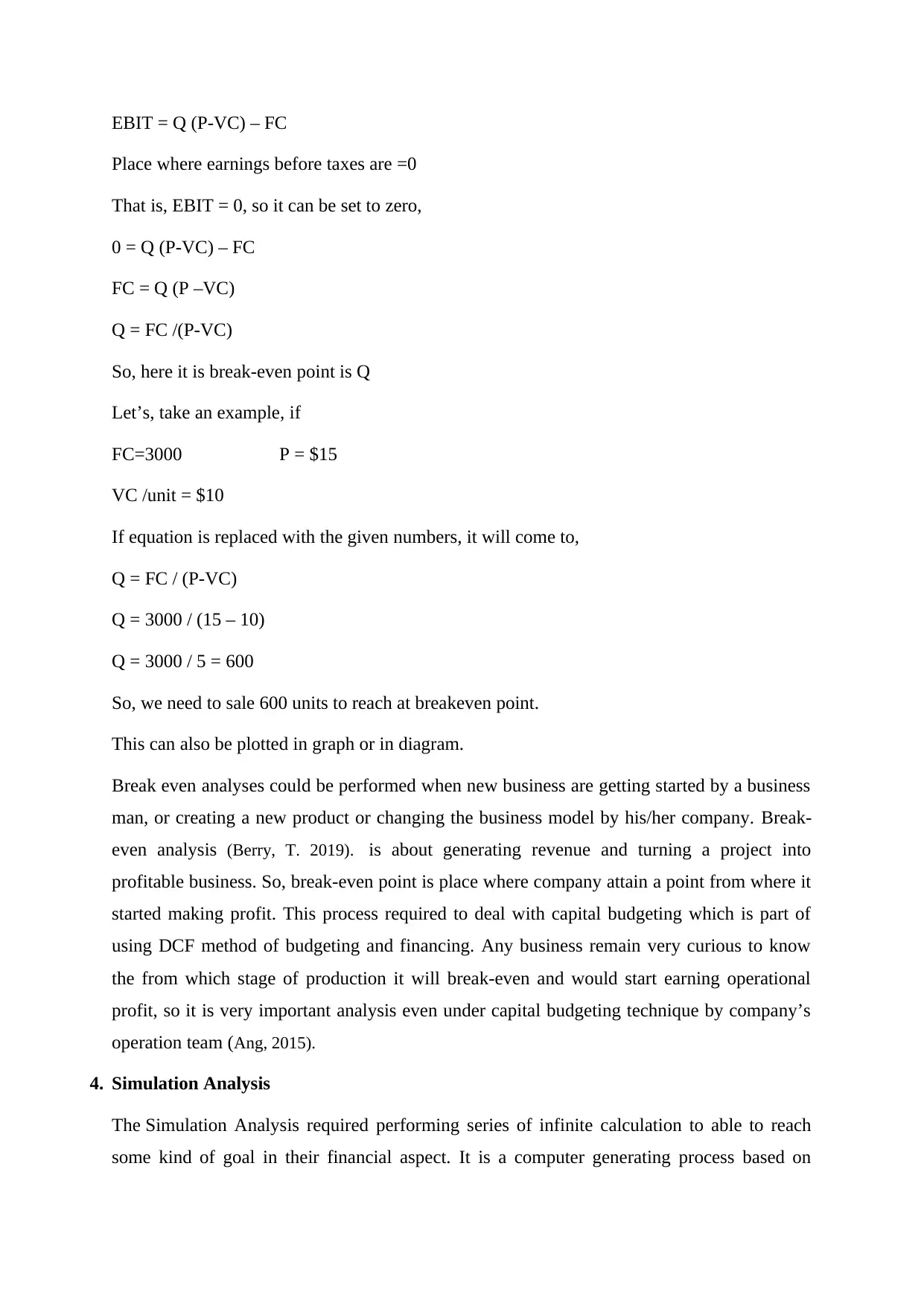
EBIT = Q (P-VC) – FC
Place where earnings before taxes are =0
That is, EBIT = 0, so it can be set to zero,
0 = Q (P-VC) – FC
FC = Q (P –VC)
Q = FC /(P-VC)
So, here it is break-even point is Q
Let’s, take an example, if
FC=3000 P = $15
VC /unit = $10
If equation is replaced with the given numbers, it will come to,
Q = FC / (P-VC)
Q = 3000 / (15 – 10)
Q = 3000 / 5 = 600
So, we need to sale 600 units to reach at breakeven point.
This can also be plotted in graph or in diagram.
Break even analyses could be performed when new business are getting started by a business
man, or creating a new product or changing the business model by his/her company. Break-
even analysis (Berry, T. 2019). is about generating revenue and turning a project into
profitable business. So, break-even point is place where company attain a point from where it
started making profit. This process required to deal with capital budgeting which is part of
using DCF method of budgeting and financing. Any business remain very curious to know
the from which stage of production it will break-even and would start earning operational
profit, so it is very important analysis even under capital budgeting technique by company’s
operation team (Ang, 2015).
4. Simulation Analysis
The Simulation Analysis required performing series of infinite calculation to able to reach
some kind of goal in their financial aspect. It is a computer generating process based on
Place where earnings before taxes are =0
That is, EBIT = 0, so it can be set to zero,
0 = Q (P-VC) – FC
FC = Q (P –VC)
Q = FC /(P-VC)
So, here it is break-even point is Q
Let’s, take an example, if
FC=3000 P = $15
VC /unit = $10
If equation is replaced with the given numbers, it will come to,
Q = FC / (P-VC)
Q = 3000 / (15 – 10)
Q = 3000 / 5 = 600
So, we need to sale 600 units to reach at breakeven point.
This can also be plotted in graph or in diagram.
Break even analyses could be performed when new business are getting started by a business
man, or creating a new product or changing the business model by his/her company. Break-
even analysis (Berry, T. 2019). is about generating revenue and turning a project into
profitable business. So, break-even point is place where company attain a point from where it
started making profit. This process required to deal with capital budgeting which is part of
using DCF method of budgeting and financing. Any business remain very curious to know
the from which stage of production it will break-even and would start earning operational
profit, so it is very important analysis even under capital budgeting technique by company’s
operation team (Ang, 2015).
4. Simulation Analysis
The Simulation Analysis required performing series of infinite calculation to able to reach
some kind of goal in their financial aspect. It is a computer generating process based on
Paraphrase This Document
Need a fresh take? Get an instant paraphrase of this document with our AI Paraphraser
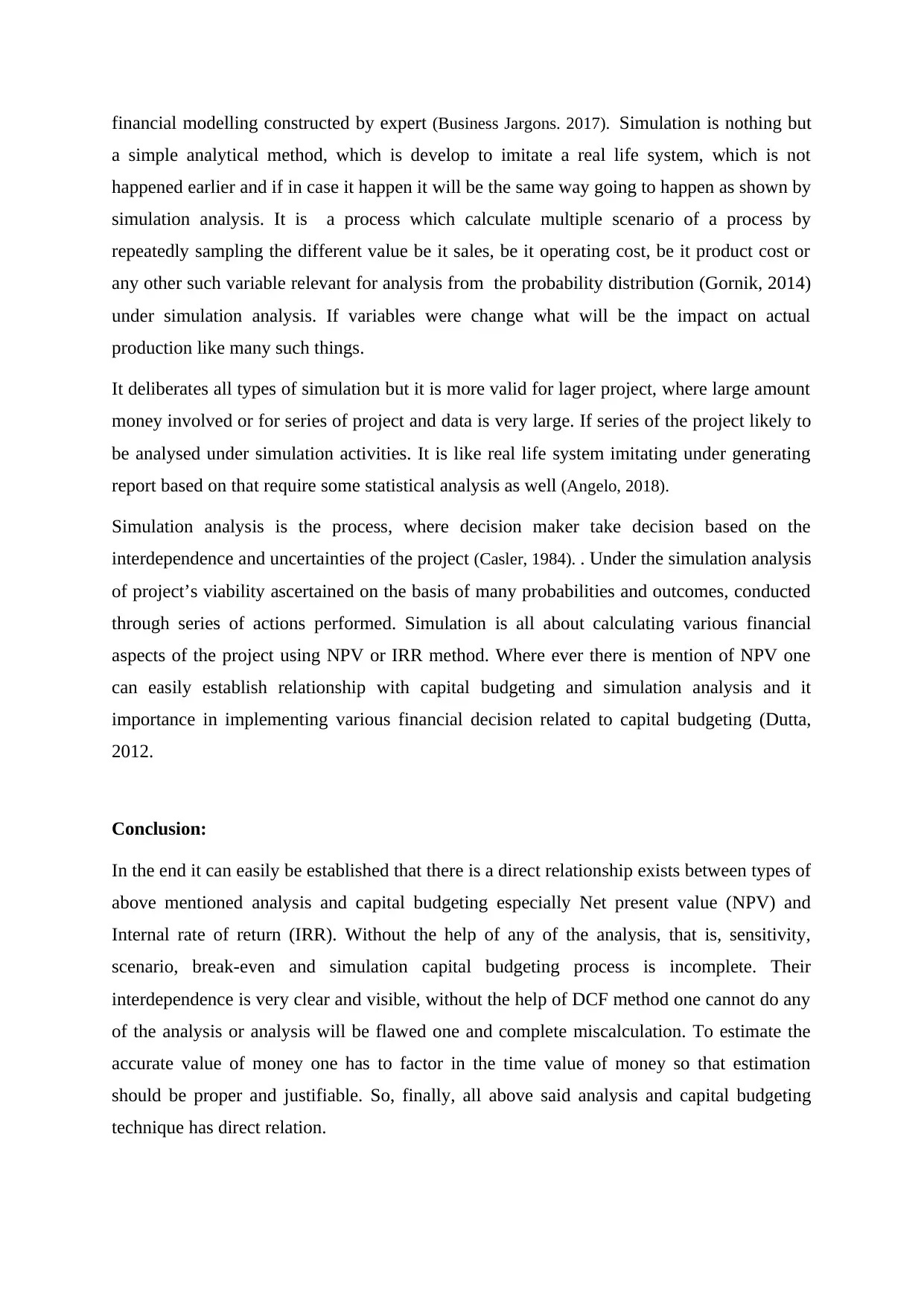
financial modelling constructed by expert (Business Jargons. 2017). Simulation is nothing but
a simple analytical method, which is develop to imitate a real life system, which is not
happened earlier and if in case it happen it will be the same way going to happen as shown by
simulation analysis. It is a process which calculate multiple scenario of a process by
repeatedly sampling the different value be it sales, be it operating cost, be it product cost or
any other such variable relevant for analysis from the probability distribution (Gornik, 2014)
under simulation analysis. If variables were change what will be the impact on actual
production like many such things.
It deliberates all types of simulation but it is more valid for lager project, where large amount
money involved or for series of project and data is very large. If series of the project likely to
be analysed under simulation activities. It is like real life system imitating under generating
report based on that require some statistical analysis as well (Angelo, 2018).
Simulation analysis is the process, where decision maker take decision based on the
interdependence and uncertainties of the project (Casler, 1984). . Under the simulation analysis
of project’s viability ascertained on the basis of many probabilities and outcomes, conducted
through series of actions performed. Simulation is all about calculating various financial
aspects of the project using NPV or IRR method. Where ever there is mention of NPV one
can easily establish relationship with capital budgeting and simulation analysis and it
importance in implementing various financial decision related to capital budgeting (Dutta,
2012.
Conclusion:
In the end it can easily be established that there is a direct relationship exists between types of
above mentioned analysis and capital budgeting especially Net present value (NPV) and
Internal rate of return (IRR). Without the help of any of the analysis, that is, sensitivity,
scenario, break-even and simulation capital budgeting process is incomplete. Their
interdependence is very clear and visible, without the help of DCF method one cannot do any
of the analysis or analysis will be flawed one and complete miscalculation. To estimate the
accurate value of money one has to factor in the time value of money so that estimation
should be proper and justifiable. So, finally, all above said analysis and capital budgeting
technique has direct relation.
a simple analytical method, which is develop to imitate a real life system, which is not
happened earlier and if in case it happen it will be the same way going to happen as shown by
simulation analysis. It is a process which calculate multiple scenario of a process by
repeatedly sampling the different value be it sales, be it operating cost, be it product cost or
any other such variable relevant for analysis from the probability distribution (Gornik, 2014)
under simulation analysis. If variables were change what will be the impact on actual
production like many such things.
It deliberates all types of simulation but it is more valid for lager project, where large amount
money involved or for series of project and data is very large. If series of the project likely to
be analysed under simulation activities. It is like real life system imitating under generating
report based on that require some statistical analysis as well (Angelo, 2018).
Simulation analysis is the process, where decision maker take decision based on the
interdependence and uncertainties of the project (Casler, 1984). . Under the simulation analysis
of project’s viability ascertained on the basis of many probabilities and outcomes, conducted
through series of actions performed. Simulation is all about calculating various financial
aspects of the project using NPV or IRR method. Where ever there is mention of NPV one
can easily establish relationship with capital budgeting and simulation analysis and it
importance in implementing various financial decision related to capital budgeting (Dutta,
2012.
Conclusion:
In the end it can easily be established that there is a direct relationship exists between types of
above mentioned analysis and capital budgeting especially Net present value (NPV) and
Internal rate of return (IRR). Without the help of any of the analysis, that is, sensitivity,
scenario, break-even and simulation capital budgeting process is incomplete. Their
interdependence is very clear and visible, without the help of DCF method one cannot do any
of the analysis or analysis will be flawed one and complete miscalculation. To estimate the
accurate value of money one has to factor in the time value of money so that estimation
should be proper and justifiable. So, finally, all above said analysis and capital budgeting
technique has direct relation.
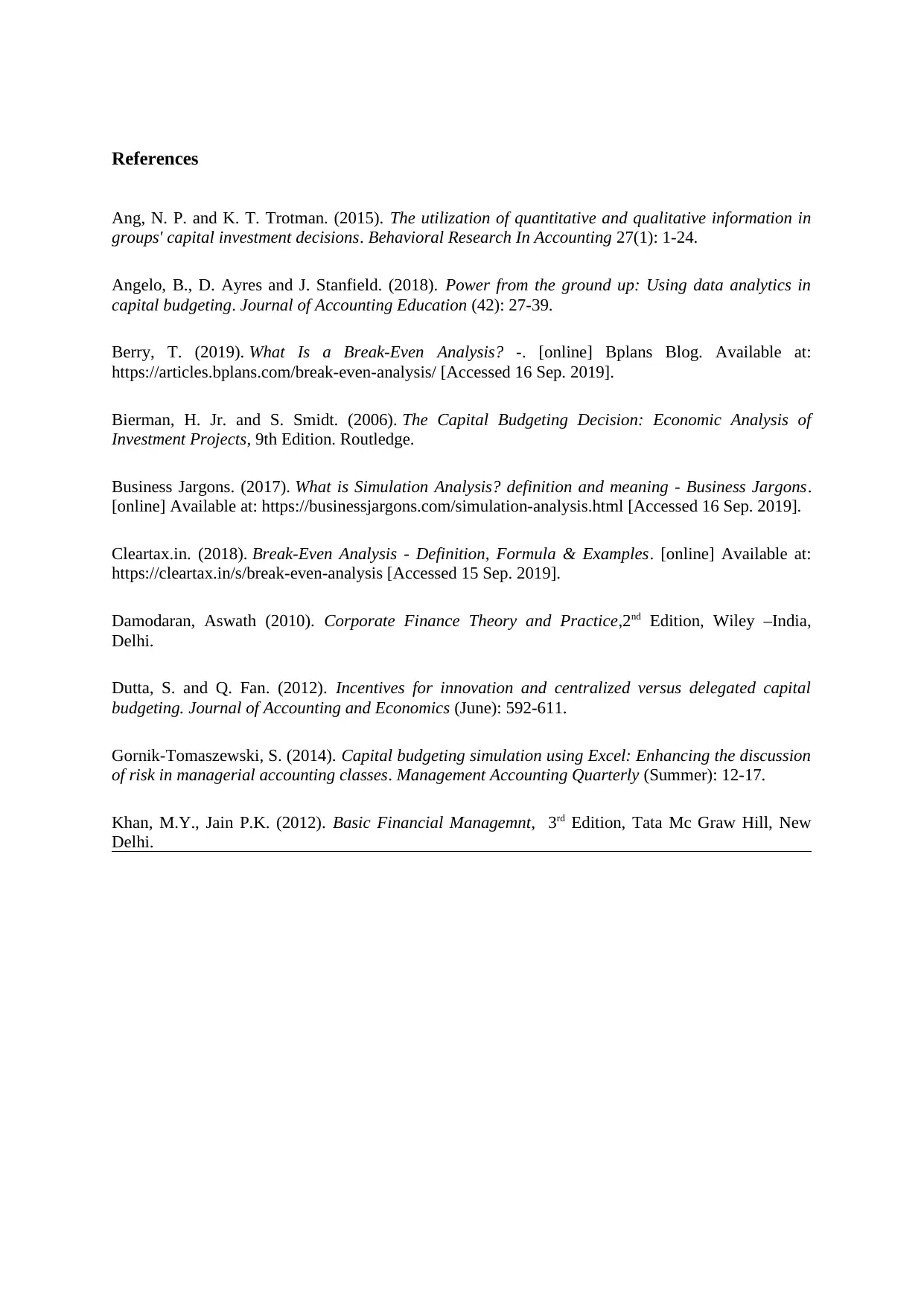
References
Ang, N. P. and K. T. Trotman. (2015). The utilization of quantitative and qualitative information in
groups' capital investment decisions. Behavioral Research In Accounting 27(1): 1-24.
Angelo, B., D. Ayres and J. Stanfield. (2018). Power from the ground up: Using data analytics in
capital budgeting. Journal of Accounting Education (42): 27-39.
Berry, T. (2019). What Is a Break-Even Analysis? -. [online] Bplans Blog. Available at:
https://articles.bplans.com/break-even-analysis/ [Accessed 16 Sep. 2019].
Bierman, H. Jr. and S. Smidt. (2006). The Capital Budgeting Decision: Economic Analysis of
Investment Projects, 9th Edition. Routledge.
Business Jargons. (2017). What is Simulation Analysis? definition and meaning - Business Jargons.
[online] Available at: https://businessjargons.com/simulation-analysis.html [Accessed 16 Sep. 2019].
Cleartax.in. (2018). Break-Even Analysis - Definition, Formula & Examples. [online] Available at:
https://cleartax.in/s/break-even-analysis [Accessed 15 Sep. 2019].
Damodaran, Aswath (2010). Corporate Finance Theory and Practice,2nd Edition, Wiley –India,
Delhi.
Dutta, S. and Q. Fan. (2012). Incentives for innovation and centralized versus delegated capital
budgeting. Journal of Accounting and Economics (June): 592-611.
Gornik-Tomaszewski, S. (2014). Capital budgeting simulation using Excel: Enhancing the discussion
of risk in managerial accounting classes. Management Accounting Quarterly (Summer): 12-17.
Khan, M.Y., Jain P.K. (2012). Basic Financial Managemnt, 3rd Edition, Tata Mc Graw Hill, New
Delhi.
Ang, N. P. and K. T. Trotman. (2015). The utilization of quantitative and qualitative information in
groups' capital investment decisions. Behavioral Research In Accounting 27(1): 1-24.
Angelo, B., D. Ayres and J. Stanfield. (2018). Power from the ground up: Using data analytics in
capital budgeting. Journal of Accounting Education (42): 27-39.
Berry, T. (2019). What Is a Break-Even Analysis? -. [online] Bplans Blog. Available at:
https://articles.bplans.com/break-even-analysis/ [Accessed 16 Sep. 2019].
Bierman, H. Jr. and S. Smidt. (2006). The Capital Budgeting Decision: Economic Analysis of
Investment Projects, 9th Edition. Routledge.
Business Jargons. (2017). What is Simulation Analysis? definition and meaning - Business Jargons.
[online] Available at: https://businessjargons.com/simulation-analysis.html [Accessed 16 Sep. 2019].
Cleartax.in. (2018). Break-Even Analysis - Definition, Formula & Examples. [online] Available at:
https://cleartax.in/s/break-even-analysis [Accessed 15 Sep. 2019].
Damodaran, Aswath (2010). Corporate Finance Theory and Practice,2nd Edition, Wiley –India,
Delhi.
Dutta, S. and Q. Fan. (2012). Incentives for innovation and centralized versus delegated capital
budgeting. Journal of Accounting and Economics (June): 592-611.
Gornik-Tomaszewski, S. (2014). Capital budgeting simulation using Excel: Enhancing the discussion
of risk in managerial accounting classes. Management Accounting Quarterly (Summer): 12-17.
Khan, M.Y., Jain P.K. (2012). Basic Financial Managemnt, 3rd Edition, Tata Mc Graw Hill, New
Delhi.
⊘ This is a preview!⊘
Do you want full access?
Subscribe today to unlock all pages.

Trusted by 1+ million students worldwide
1 out of 6
Related Documents
Your All-in-One AI-Powered Toolkit for Academic Success.
+13062052269
info@desklib.com
Available 24*7 on WhatsApp / Email
![[object Object]](/_next/static/media/star-bottom.7253800d.svg)
Unlock your academic potential
Copyright © 2020–2025 A2Z Services. All Rights Reserved. Developed and managed by ZUCOL.




